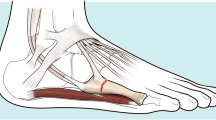Abstract
Background
Lacking rational basis for the postoperative treatment of fifth metatarsal avulsion fractures.
Methods
Biomechanical test of stability of tension banding and screw fixation of fifth metatarsal avulsion fractures in cadaver specimen, sonographic measuring of the maximum cross-section of the peroneus brevis muscle, electromyographic examinations of the activity of the peroneus brevis muscle at different loads and means of immobilization.
Results
The forces acting on the base of the fifth metatarsal bone during voluntary activation of the peroneus brevis muscle or activation in the gait cycle are of the same magnitude as the failure forces of internal fixation. Immobilization of the talocrural joint achieves no reduction in muscle activation. Partial weight bearing reduces muscle activation.
Conclusions
The postoperative treatment after osteosynthesis of fifth metatarsal avulsion fractures should be partial weight bearing. For safety reasons we add an elastic ankle orthesis to prevent supination. A below-knee cast is not necessary.

Similar content being viewed by others
References
Dameron TB (1995) Fractures of the proximal fifth metatarsal: selecting the best treatment option. J Am Acad Orthop Surg 3(2):110–114
Schmidt RF, Thews G (1995) Physiologie des Menschen. Springer, Berlin, p 76
Dameron TB (1975) Fractures and anatomical variations of the proximal portion of the fifth metatarsal. J Bone Joint Surg. 57-A(9):788–792
Lawrence SJ, Botte MJ (1993) Jones fractures and related fractures of the proximal fifth metatarsal. Foot Ankle 14(6):358–365
Thordarson DB (2000) Fractures of the midfoot and forefoot. In: Myerson MS (ed) Disorders of the foot and ankle. WB Saunders, Philadelphia, pp 1265–1296
Rockwood CA, Green DP (1975) Fractures. Lippincott, Philadelphia, pp 1482–1483
Giordano AR, Fallat LM (2004) Strength analysis of intraosseus wire fixation for avulsion fractures of the fifth metatarsal base. J Foot Surg 43(4):225–230. doi:10.1053/j.jfas.2004.05.005
Moshirfar A, Campbell JT, Molloy S, Jasper LE, Belkoff SM (2003) Fifth metatarsal tuberosity fracture fixation: a biomechanical study. Foot Ankle Int 24(8):630–633
Heineck J, Liebscher T, Zwipp H (2001) Fifth metatarsal base avulsion fractures. Orthop Traumatol 2:141–147
Schmidt RF, Thews G (1995) Physiologie des Menschen. Springer, Berlin, p 75
Zeeshan S, Husain BS, Donna J, DeFronzo DPM (2000) Relative stability of tension band versus two-cortex screw fixation for treating fifth metatarsal base avulsion fractures. J Foot Surg 39(2):89–95
Author information
Authors and Affiliations
Corresponding author
Rights and permissions
About this article
Cite this article
Heineck, J., Wolz, M., Haupt, C. et al. Fifth metatarsal avulsion fracture: a rational basis for postoperative treatment. Arch Orthop Trauma Surg 129, 1089–1092 (2009). https://doi.org/10.1007/s00402-008-0756-x
Received:
Published:
Issue Date:
DOI: https://doi.org/10.1007/s00402-008-0756-x




